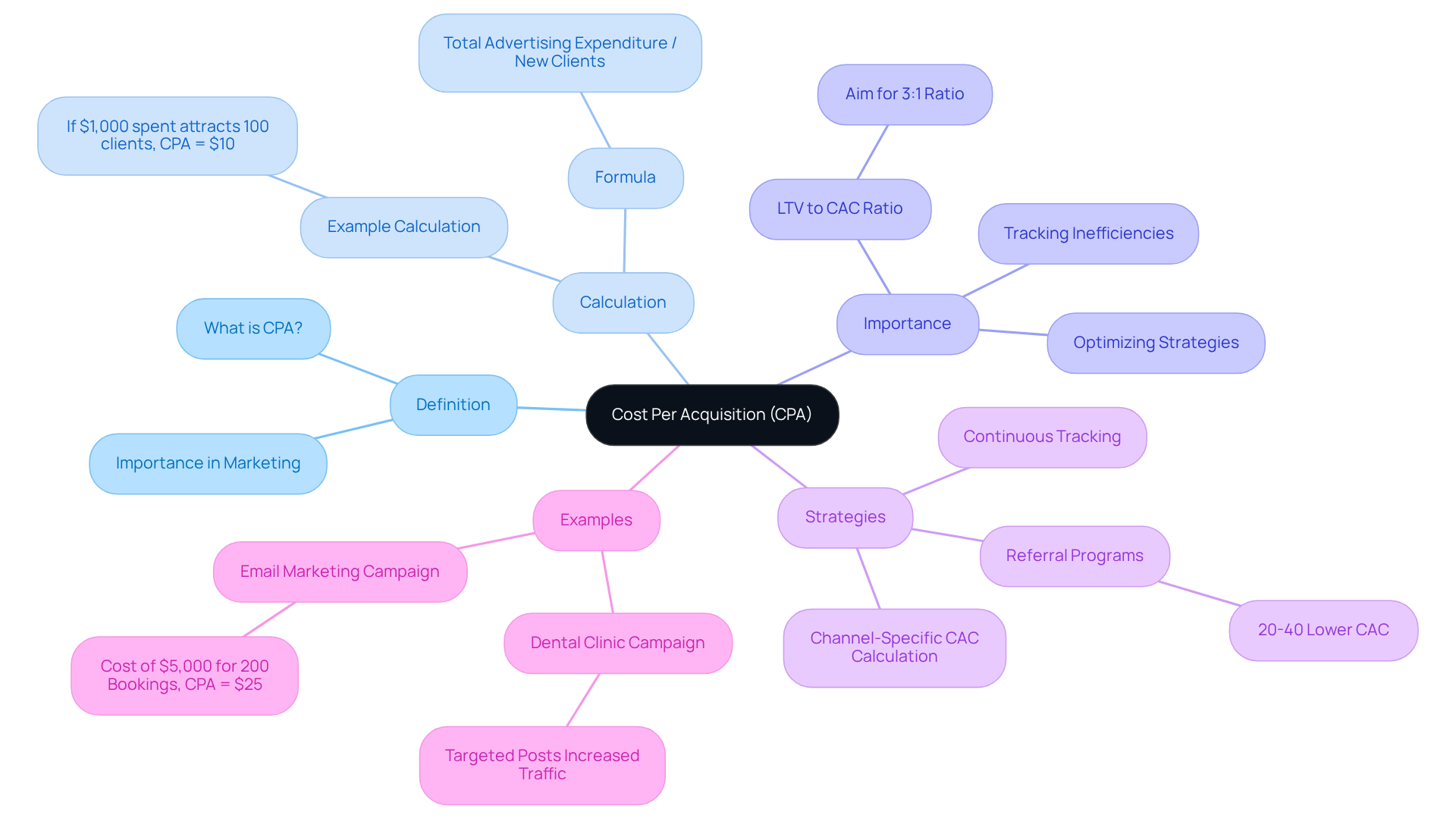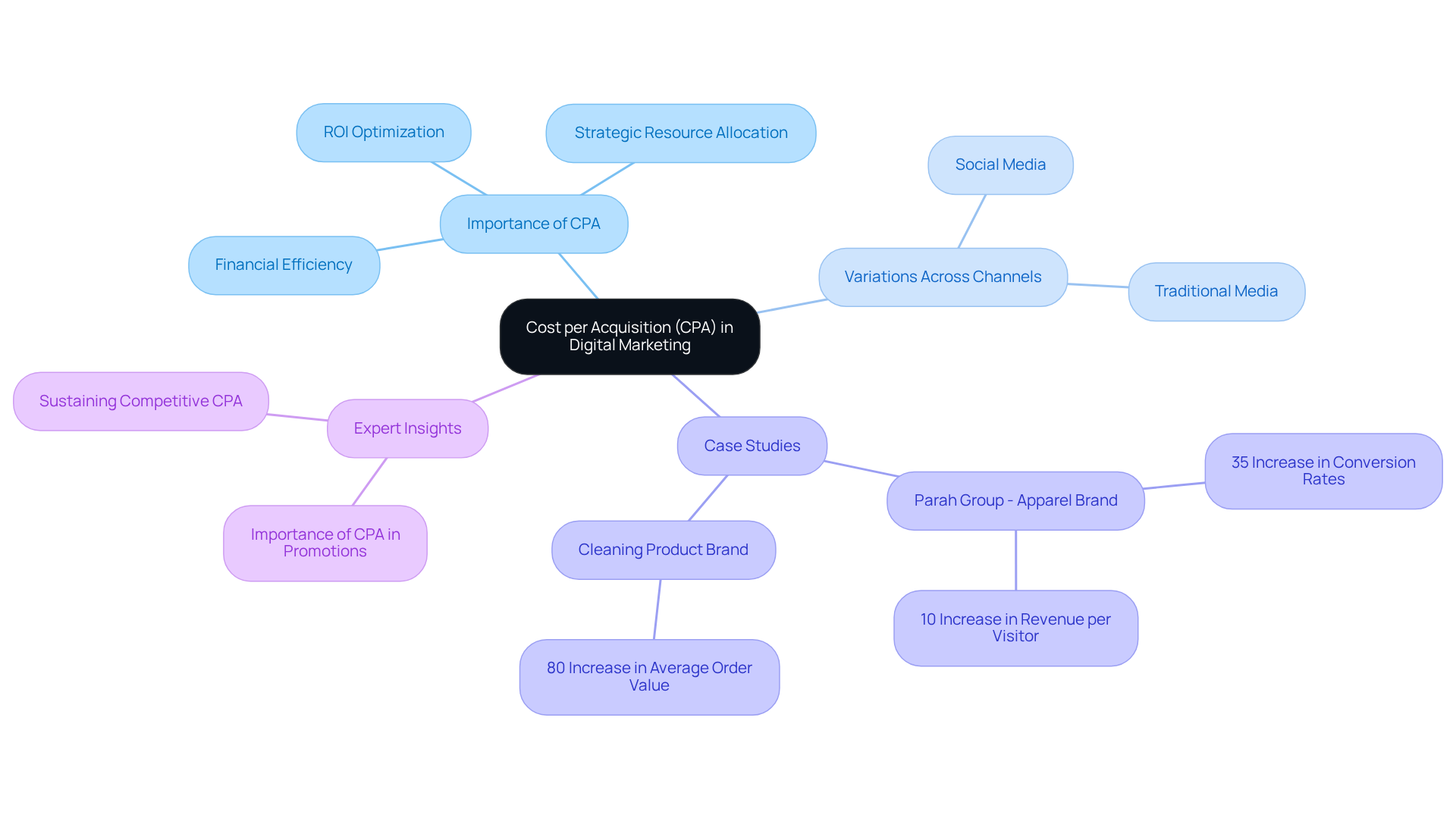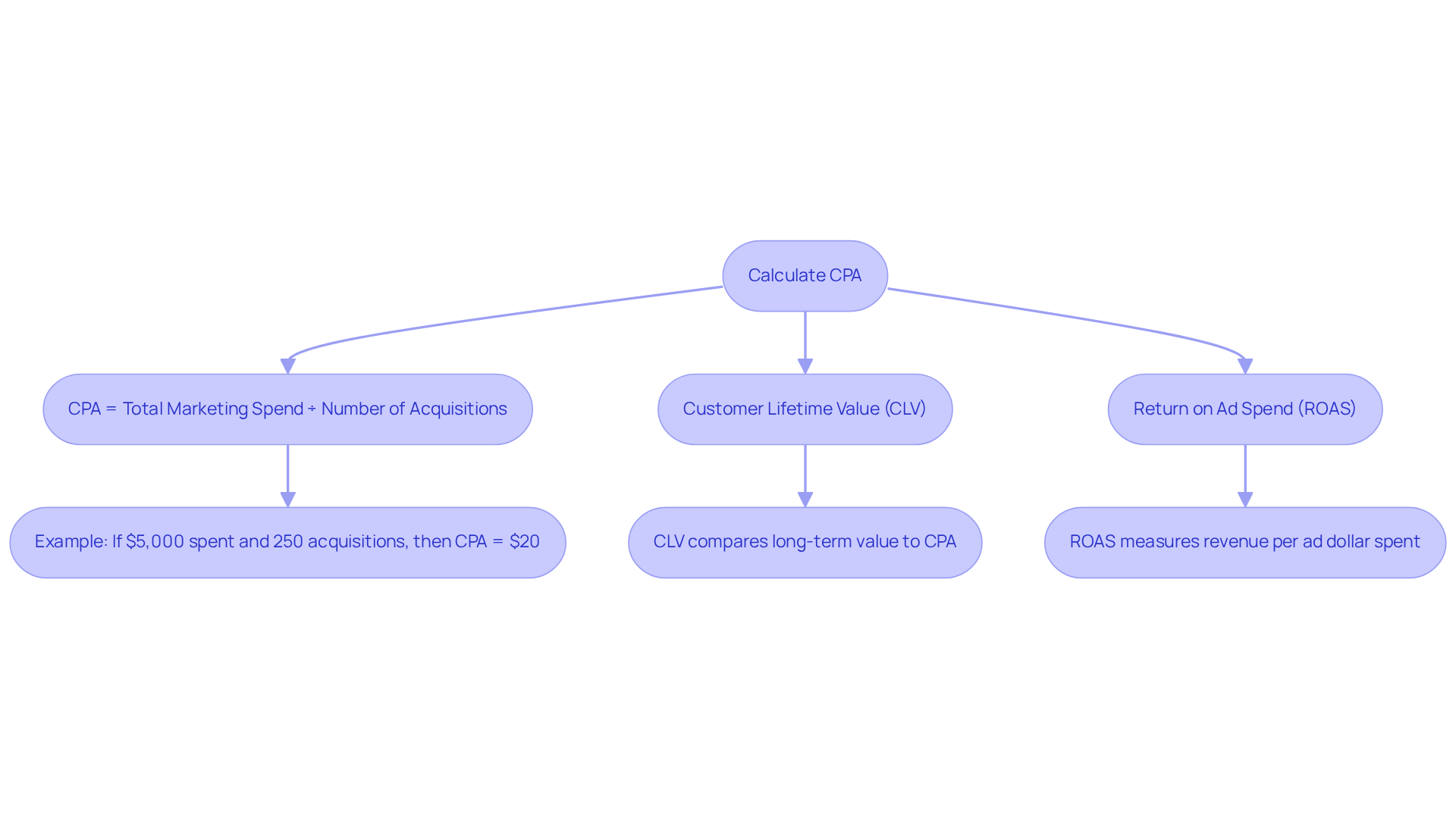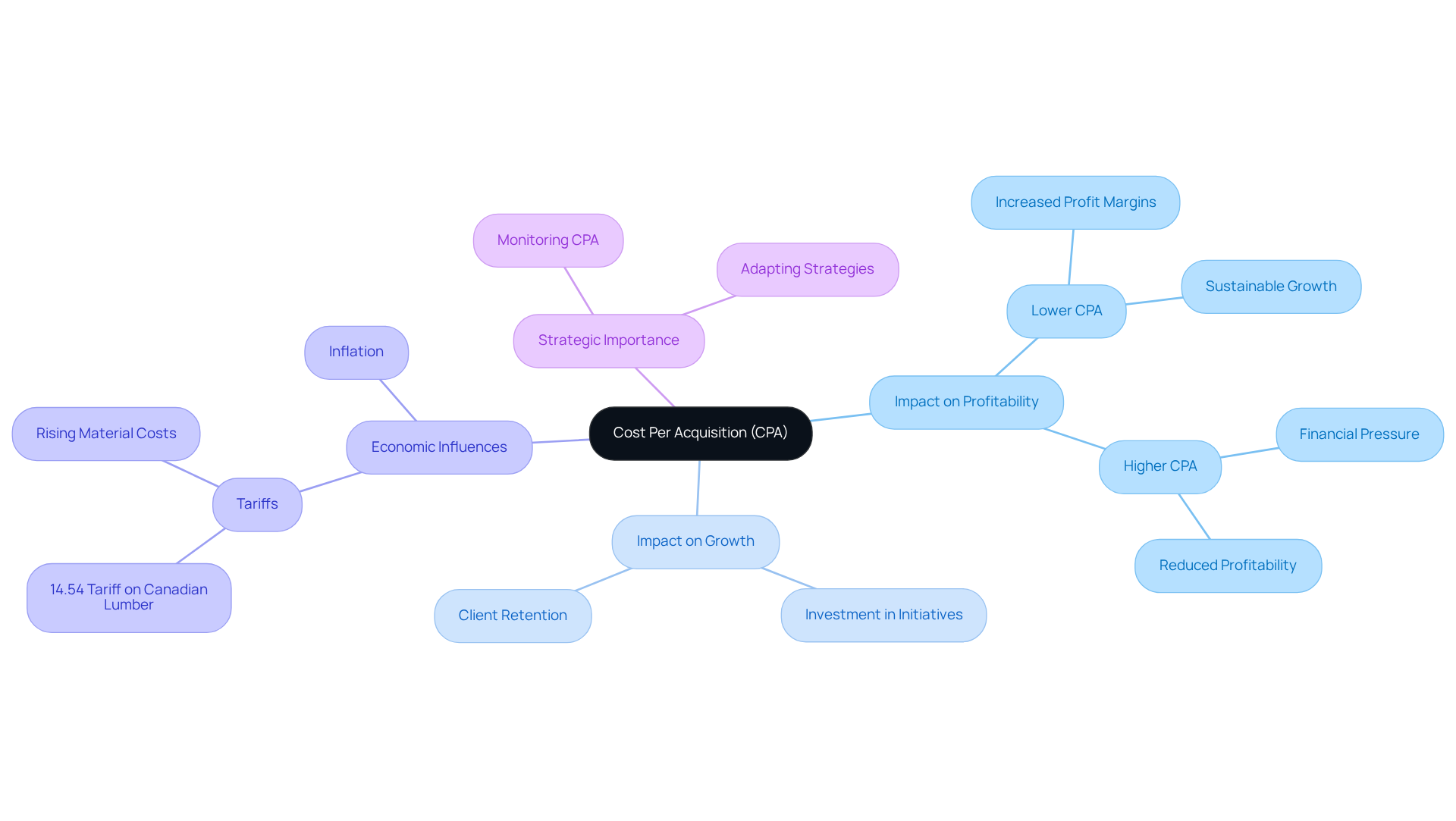
Overview
The article delves into the critical metric of cost per acquisition (CPA) in digital marketing, underscoring its calculation, significance, and effect on business profitability and growth. A well-optimized CPA is essential; it empowers businesses to allocate resources effectively and maximize their return on investment. This assertion is supported by case studies that demonstrate enhanced profitability through strategic CPA management and conversion rate optimization. By mastering CPA, organizations can not only improve their financial outcomes but also position themselves for sustained growth in a competitive landscape.
Introduction
Cost per acquisition (CPA) is a critical metric in digital marketing, serving as a key indicator of the effectiveness of promotional investments. In an increasingly competitive landscape, businesses must grasp CPA to optimize their marketing strategies and enhance profitability. Yet, with rising customer acquisition costs and fluctuating market dynamics, how can companies ensure their CPA remains sustainable while driving growth?
This article explores the intricacies of CPA, its calculation, and its significant impact on business success, providing insights that can transform marketing efforts for the better.
Define Cost Per Acquisition (CPA)
Cost per acquisition (CPA) is a crucial metric that assesses the overall investment needed to acquire a new client or encourage a user to perform a specific action, like making a purchase or subscribing to a newsletter. To calculate the cost per acquisition, simply divide the total advertising expenditure by the number of new clients acquired within a defined timeframe. For instance, if a company allocates $1,000 to a promotional campaign and successfully attracts 100 new clients, the CPA would amount to $10. This metric is indispensable for assessing the effectiveness of promotional campaigns and is frequently utilized in CPA bidding strategies to optimize the cost per acquisition of advertising.
As we look to 2025, the dynamics of cost per acquisition are continually shifting, with businesses increasingly prioritizing a balanced approach between CPA and customer lifetime value (LTV). Aiming for a LTV to CAC ratio of at least 3:1 has emerged as a benchmark for sustainable growth. Companies that diligently track their cost per acquisition can identify inefficiencies and adjust their strategies accordingly, ensuring that their promotional efforts yield maximum returns. For example, a dental clinic that executed targeted promotional posts within its community witnessed a significant increase in traffic to their landing page, demonstrating how effective CPA strategies can enhance visibility and drive engagement.
Understanding cost per acquisition not only facilitates budget forecasting but also empowers companies to refine their promotional strategies to enhance profitability. As the digital marketing landscape intensifies in competitiveness, the ability to accurately calculate and analyze cost per acquisition will remain a fundamental aspect of effective strategies. Moreover, it is crucial to acknowledge that clients acquired through referrals typically exhibit a 20-40% lower CAC, underscoring the efficacy of diverse acquisition methods. Continuous monitoring of cost per acquisition is vital for optimizing promotional strategies.

Explain the Importance of CPA in Digital Marketing
Cost per acquisition (CPA) serves as a pivotal metric in the digital landscape, acting as a direct indicator of the financial efficiency of advertising initiatives. By scrutinizing the cost per acquisition, marketers can evaluate the cost-effectiveness of their campaigns, thereby enabling strategic resource allocation. A lower cost per acquisition indicates a more effective promotional strategy, empowering businesses to optimize their return on investment (ROI). Brands that have engaged in rigorous cost per acquisition analysis have documented significant enhancements in their ROI, underscoring the tangible advantages of using this metric.
In 2025, the average CPA fluctuates across various digital marketing channels, mirroring the distinct dynamics of each platform. Grasping these variations is essential for marketers intent on refining their strategies. For example, social media advertising often presents a lower cost per acquisition compared to traditional media, making it an appealing option for brands focused on enhancing their client acquisition efforts.
The case studies from Parah Group exemplify the transformative effect of conversion rate optimization (CRO) on cost per acquisition. A $30M apparel brand that collaborated with Parah Group experienced a 35% increase in conversion rates after optimizing product pricing and gamifying the shopping experience. This not only improved their cost per acquisition but also elevated their revenue per visitor by 10%. In a similar vein, a cleaning product brand witnessed an 80% increase in average order value through strategic bundling and pricing tests, illustrating how effective CRO can lead to reduced customer acquisition costs and increased profitability.
Expert insights underscore the importance of cost per acquisition (CPA) in evaluating the efficiency of promotions. A well-maintained CPA aids in identifying the most effective channels and facilitates data-driven adjustments that can significantly enhance overall performance. As client acquisition costs continue to rise, sustaining a competitive cost per acquisition (CPA) is vital for long-term profitability. By focusing on cost per acquisition, brands can ensure that their promotional strategies remain agile and responsive to market fluctuations, ultimately fostering sustainable growth.

Outline How to Calculate CPA and Key Metrics
The straightforward process for calculating cost per acquisition (CPA) is:
- CPA = Total Marketing Spend ÷ Number of Acquisitions.
For instance, if a company invests $5,000 in a campaign and successfully gains 250 new clients, the CPA would be $20. This metric is crucial for evaluating the cost per acquisition related to marketing investments. Key metrics related to CPA include:
- Customer Lifetime Value (CLV), which assesses the long-term worth an individual brings compared to the CPA. Understanding CLV enables businesses to determine whether their acquisition costs are justified by the revenue generated over the customer's lifetime.
- Return on Ad Spend (ROAS), which is vital, measuring the revenue earned for every dollar spent on advertising. For example, if a campaign produces $20,000 in sales from a $5,000 ad expenditure, the ROAS would be 4:1, suggesting efficient promotion.
By analyzing cost per acquisition alongside CLV and ROAS, businesses can gain a comprehensive view of their promotional performance, allowing for informed decisions that enhance profitability and growth.
To enhance profitability, it is essential to incorporate thorough Conversion Rate Optimization (CRO) approaches into your promotional efforts. With over 10 years of agency and in-house media buying experience, we recognize that rigorous testing and alignment of paid ads and landing pages can significantly improve conversion rates. Our clients typically observe a substantial rise in their conversion rates after applying customized CRO techniques. Ongoing observation and modification of the cost per acquisition according to performance data are crucial for refining marketing strategies and securing long-term profitability.
Furthermore, comparing cost per acquisition with industry benchmarks can provide context on what constitutes a good cost per acquisition in different sectors. It is also vital to consider the quality of acquisitions; pursuing a lower CPA without regard for quality can lead to ineffective client acquisition strategies. Robust tracking systems are necessary to monitor user interactions and conversions effectively, ensuring accurate CPA calculations and analyses.

Discuss the Impact of CPA on Business Profitability and Growth
The significance of cost per acquisition (CPA) in driving business profitability and growth is crucial. An effectively optimized cost per acquisition (CPA) ensures that the cost of acquiring clients remains lower than the revenue they generate. For instance, when a business allocates $100 to acquire a client who subsequently generates $150 in revenue, this sustainable CPA positively influences profitability. Conversely, a high cost per acquisition can create financial pressure, hindering a company's ability to scale efficiently. Organizations that actively monitor and refine their cost per acquisition (CPA) are better equipped to channel resources into growth initiatives, enhance client retention, and bolster their competitive edge in the market.
In today's economic landscape, where tariffs are influencing costs and profitability, understanding the broader context of cost per acquisition is essential. For example, the U.S. imposes a 14.54% tariff on Canadian softwood lumber, which can significantly affect construction costs and, consequently, the CPA for businesses in that sector. As Richard Socher, CEO, aptly notes, "Higher expenses often result in increased consumer prices, lower profit margins, or shifts in sourcing and supply chain restructuring to reduce exposure." This underscores the necessity for DTC brands to adapt their cost per acquisition strategies in response to external economic pressures.
Furthermore, firms that diligently track and enhance their cost per acquisition are better positioned to invest in growth initiatives, improve client retention, and boost overall market competitiveness. In an era where customer acquisition costs are escalating, maintaining a favorable cost per acquisition (CPA) is crucial for achieving long-term success and resilience in the digital economy.

Conclusion
Understanding cost per acquisition (CPA) is crucial for businesses striving to optimize their marketing strategies and enhance profitability. This metric quantifies the investment required to gain new clients and serves as a pivotal tool for assessing the effectiveness of promotional efforts. Mastering CPA ensures that customer acquisition costs are sustainable and aligned with revenue goals.
The article underscores key aspects of CPA, including its calculation, significance in digital marketing, and its impact on overall business growth. It emphasizes the necessity of tracking CPA alongside other metrics, such as customer lifetime value (CLV) and return on ad spend (ROAS), to achieve a comprehensive understanding of marketing performance. Real-world examples, including successful case studies from various brands, illustrate how effective CPA strategies can lead to increased conversion rates and improved profitability.
In today's competitive landscape, the ability to accurately calculate and analyze cost per acquisition is vital for sustained success. Businesses must continuously monitor their CPA, adapt strategies to market changes, and invest in optimizing promotional efforts. By prioritizing CPA, organizations can enhance marketing efficiency and foster long-term growth and resilience against economic fluctuations. Embracing this approach empowers brands to navigate the complexities of customer acquisition effectively, ensuring a prosperous future.
Frequently Asked Questions
What is Cost Per Acquisition (CPA)?
Cost per acquisition (CPA) is a metric that measures the total investment required to acquire a new client or prompt a user to take a specific action, such as making a purchase or subscribing to a newsletter.
How is CPA calculated?
CPA is calculated by dividing the total advertising expenditure by the number of new clients acquired within a specific timeframe. For example, if a company spends $1,000 on a campaign and gains 100 new clients, the CPA would be $10.
Why is CPA important for businesses?
CPA is essential for evaluating the effectiveness of promotional campaigns and is often used in CPA bidding strategies to optimize advertising costs. It helps businesses identify inefficiencies and adjust their strategies for better returns.
What is the relationship between CPA and customer lifetime value (LTV)?
Businesses are increasingly focusing on balancing CPA with customer lifetime value (LTV). Aiming for a LTV to customer acquisition cost (CAC) ratio of at least 3:1 is considered a benchmark for sustainable growth.
How can companies improve their CPA strategies?
Companies can enhance their CPA strategies by tracking their cost per acquisition, refining promotional tactics, and utilizing targeted campaigns that can increase visibility and engagement, as demonstrated by successful case studies.
What role does referral acquisition play in CPA?
Clients acquired through referrals generally have a 20-40% lower customer acquisition cost (CAC), highlighting the effectiveness of various acquisition methods in reducing overall costs.
Why is continuous monitoring of CPA important?
Continuous monitoring of CPA is crucial for optimizing promotional strategies, ensuring that businesses can adapt to changes in the market and maximize their investment returns.
FAQs











